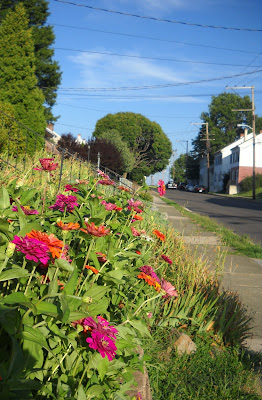Mother and daughter create sanctuary for reflection
By Jennifer Hetrick
Tucked away in a rural sweep off of Detweiler Road in Upper Pottsgrove Township is Beaufort’s Run Sanctuary.
Five years ago, Barb Shontz decided to cultivate a portion of her property into a nature-oriented setting that could be appreciated by any members of the community who ventured to it.
Since 2001, after she lost her beloved standard poodle Beaufort to cancer very suddenly, she wanted to create something positive in his memory.
The idea finally came to her when she read about healing gardens in Birds & Blooms Magazine.
“We all suffer losses, whether human or animal, and our spirit is broken,” Shontz said. “We need a place to retreat where there is peace and solace—a place to go to have our questions answered.”
( A view of the a part of the trail at Beaufort's Run Sanctuary. Photograph by Sue Hughes. )
“We need to go into the woods where we can bond with nature and try to understand the meaning of it all,” Shontz said.
( Beaufort's Run Sanctuary is a certified wildlife habitat through
the National Wildlife Federation. Photograph by Sue Hughes. )
( A small patch of Fern growing at Beaufort's Run Sanctuary. Photograph by Sue Hughes. )
A main component of the project Shontz said she hopes will benefit the community is inviting them to plant healing gardens for past loved ones or for dirt and earth healing efforts in general, especially for those who don’t have space for such meaningful landscapes outside of their own homes.
Shontz’ property sits on 10 acres, with the trail of Beaufort’s Run Sanctuary circling around her yard.
( Beaufort's Run Sanctuary's trail is approximately half a mile long. Photograph by Sue Hughes. )
Much of the physical labor of developing the sanctuary has been accomplished by Shontz’ daughter Sue Hughes, an East Coventry Township resident.
In spring and fall, Hughes spends about five hours a day, three days a week, working on the trail and gardens.
“There has to be connection with a bigger picture,” Hughes said, “and I think nature provides that.”
( In fall, Beaufort's Run Sanctuary is ablaze in leaves turning colors
before they drop from trees. Photograph by Sue Hughes. )
The sanctuary is brimming with many native plants, including the recent addition of American Ginseng.
Eagle Scouts helped to build benches and birdhouses, and neighbors have donated plants.
“We’re planting meadows, and I want a pond eventually,” Shontz said, adding that they are always grateful for assistance from any individuals or groups who value what this type of setting has to offer to the community.
Shontz and Hughes are pursuing non-profit status for Beaufort’s Run Sanctuary so that it can be a more direct benefit to members of the community, especially children.
Hughes said she is largely interested in using the elements of the trail as a way to educate homeschooled children about ecology, the natural environment, and forest stewardship.
Mentioning a term first recognized in 2005, Nature Deficit Disorder, Hughes readily advocates getting children outside and away from the monotony of technology today.
Two years in a row, My Little Chickadee Bird Store in Douglassville sponsored a spring bird walk at the sanctuary, led by Vince Smith of the Valley Forge Audubon Society.
The bird walks were limited in how many could take the tours, as too many people on foot would discourage the winged ones from staying nearby.
( A White Breasted Nuthatch photographed by Sue Hughes' son Eric. )
The woodchip-made trail has already become well traveled by people bringing their dogs for walks and others who are searching for the geocache, or a hidden container on the property.
According to
www.geocaching.com, this hip new hobby “is a high-tech
treasure hunting game played throughout the world by adventure seekers equipped with
GPS devices.”
Hughes said when she placed the geocache along the trail in 2008, the number of visitors to the sanctuary multiplied, with several geocachers from surrounding states.
“I don’t know of anything else like it in our area,” Hughes said about the sanctuary, noting the personal nature of it as one of its unique attributes.
“Nature is beautiful, important, and relaxing,” Hughes said. “Sometimes you can turn off your cell phone or iPod and really experience peace.”
















































